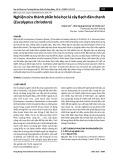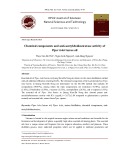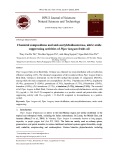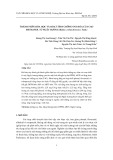
23
CHEMICAL CONSTITUENTS OF THE ESSENTIAL OIL FROM THE
RHIZOMES OF ZINGIBER OFFICINALE COLLECTED
IN CẢ PASS MOUNTAIN REGION, VIETNAM
Nguyễn Hoàng Sa
Trường Đại học Khánh Hòa
Thông tin chung:
Ngày nhận bài: 26/04/2024
Ngày phản biện: 28/04/2024
Ngày duyệt đăng: 18/05/2024
Tác giả chính:
nguyenhoangsa@ukh.edu.vn
Title:
Thành phần hóa học từ thân rễ
loài gừng (Zingiber officinale)
được thu hái tại vùng núi đèo
Cả, Việt Nam
Keywords:
Zingiber officinale, essential
oil, limonene, α-pinene,
β-caryophyllene.
Từ khóa:
Gừng, tinh dầu, limonene,
α-pinene, β-caryophyllene.
TÓM TẮT: Thành phần hóa học của dầu gừng từ thân rễ tươi
của loài Zingiber officinale đã được phân tích bằng GC-MS.
Tinh dầu chủ yếu chứa các hợp chất monoterpenoid và
sesquiterpenoid, bao gồm α-pinene, limonene, δ-3-carene,
γ-terpinene, α-phellandrene và β-caryophyllene.
ABSTRACT: The chemical composition of the ginger oil from
fresh rhizomes of Zingiber officinale was analyzed by GC-MS.
The essential oil consists predominantly of monoterpenoids and
sesquiterpenoids, including α-pinene, limonene, δ-3-carene,
γ-terpinene, α-phellandrene, and β-caryophyllene.
1. Introduction
The genus Zingiber includes around 85
herb species mainly found in East Asia,
Southeast Asia, and tropical Australia. These
plants have garnered attention for their
significant roles in both traditional medicine and
culinary practices across various cultures [1].
Investigation into Zingiber rhizomes has
unveiled bioactive constituents, including
gingerols and shogaols, which are renowned for
their potent antibacterial properties [2,3].
Additionally, a diverse array of compounds,
comprising diarylheptanoids [4],
phenylbutenoids [5], flavanoids [6],
diterpenoids [7], and sesquiterpenoids [8],
paradol, gingerdiols, dehydrogingerdione,
phenylpropanoid, steroids [9] have been
identified within this genus (Figure. 1).
Extensive research efforts have focused on
elucidating the chemical profiles of essential oil
derived from these plants and exploring their
pharmacological effects [10-15].
Among the Zingiber species, Zingiber
officinale stands out as a globally recognized
botanical with a rich history of utilization
both as a culinary spice and a medicinal
agent. It has been used to treat stomach ache,
diarrhea, stroke, diabetes, asthma, toothache
and arthritis [16, 17]. Notably, specific
bioactive constituents within Z. officinale,
such as sesquiterpenes, diarylheptanoids, and
gingerol derivatives, have been the subject of
extensive study due to their documented anti-
inflammatory, anti-emetic, and analgesic

24
properties [18-21]. This study provides initial
qualitative insights into the organic
compounds present in ginger rhizomes,
focusing on assessing the essential oil content
in freshly collected samples. The analytical
approach involves the utilization of gas
chromatography-mass spectrometry (GC-
MS) to identify and quantify the various
constituents constituting ginger essential oil.

25
Figure 1. The chemical structures of some compounds isolated from Zingiber sp. [2-15]
2. Materials and methods
2.1. Herb materials
Rhizomes of Zingiber officinale were
collected in September 2021 in the Cả Pass
mountain region, Hoa Tam, Dong Hoa, Phu
Yen province, and authenticated by Assoc.
Prof. Do Huu Thu from the Institute of
Ecology and Biological Resources, Vietnam
Academy of Science and Technology (VAST).
Voucher specimen (No. Zo.01) is deposited in
the Laboratory of Drug Research and
Discovery, Institute of Chemistry, VAST,
Hanoi, Vietnam. The fresh rhizome sample
was cleaned, pulverized, and used for analysis.
2.2. Essential oil extraction
The fresh ginger rhizomes (350 g) were
steam distilled with 500 mL of water for 3
hours. The distillate was collected, extracted
twice with 100 mL of diethyl ether, and then
dried using anhydrous sodium sulfate. Upon
evaporation of the solvent, 7.72g (2.21%) of
essential oil was obtained, based on the initial
weight of the rhizomes. For GC-MS spectral
analysis, 1.5 mg of the oil was dissolved in
1.0 mL of dried pure n-hexane (over
anhydrous sodium sulfate). The essential oil
underwent GC-MS analysis.
2.3. GC-MS analysis
GC-MS was carried out on the Agilent
Technologies USA HP 6890N Plus equipment,
with a Mass selective detector: HP5973 MSD.
Compounds were separated on HP-5MS
capillary column (0.25 μm × 30 m × 0.25 mm)
and HP1 (0.25 μm × 30m × 0.32 mm).
Samples were injected with a split ratio of 10:1
and a helium flow rate of 1.0 mL/min (carrier
gas). Other conditions included an oven
temperature up to 60oC/2 min. hold, and up to
220oC at a rate of 5 deg/min. hold. The injector
temperature was maintained at 220oC. The
column was connected directly to the Mass
Spectrometer operated in the electron
ionization mode at 70 eV, with ion source
temperature at 230°C, MS transfer line at
280°C, and a scan rate of 1.94/second.. The
constituents were identified by comparing them
with those available in the Willey/Chemstation
HP Library attached to the GC-MS instrument
and reported data [22-25].
3. Results and discussion
The rhizomes' essential oil compositions,
obtained through steam distillation, were
analyzed using GC-MS method. 51
components, representing > 93% of the total
peak area, were identified in the essential oil.

26
These components are detailed in Table 1.
The analysis revealed that key components
like α-pinene (6.55%), limonene (6.83%), δ-
3-carene (5.74%), γ-terpinene (5.75%),
α-phellandrene (5.57%), and β-caryophyllene
(11.72%) exist in varying quantities within
the essential oil.
Table 1. Chemical components detected in GC-MS spectra
of the rhizomes of Zingiber officinale essential oil.
No
Compound
Molecular
formula
M.W. (g/mol)
RT
(min)
Peak area
(percentage, %)
α-thujene
C10H16
136
6.24
0.85
α-pinene
C10H16
136
6.42
6.55
sabinene
C10H16
136
7.12
1.08
camphene
C10H16
136
7.24
3.83
verbenene
C10H16
136
7.56
0.28
β-myrcene
C10H16
136
7.96
3.01
α-phellandrene
C10H16
136
8.23
5.57
δ-3-carene
C10H16
136
8.38
5.74
α-terpinene
C10H16
136
8.54
0.77
o-cymene
C10H14
134
8.77
4.42
(E)-β-ocimene
C10H16
136
9.37
1.33
limonene
C10H16
136
10.31
6.83
γ-terpinene
C10H16
136
10.62
5.75
α-terpinolene
C10H16
136
10.90
0.79
linalool
C10H18O
154
11.00
0.31
lyrtenol
C10H16O
152
12.12
0.19
trans-alloocimene
C10H16
136
11.20
0.27
camphor
C10H16O
152
11.45
0.14
borneol
C10H18O
154
11.67
0.37
α-thujenal
C10H14O
150
11.62
0.48
α-terpineol
C10H18O
154
11.89
0.98
myrtenal
C10H14O
150
12.09
4.18
geranyl acetate
C12H20O2
196
12.23
4.58
thymol methyl ether
C11H16O
164
12.34
0.15
(E)-citral
C10H16O
152
12.67
0.35
4-(1-methylethyl)-
benzaldehyde
C10H12O
148
12.79
0.32
bornyl acetate
C12H20O2
196
12.89
1.21
bicycloelemene
C15H24
204
13.27
0.12
myrtenyl acetate
C12H18O2
194
13.36
0.59
β-panasinsene
C15H24
204
13.58
0.42
α-copaene
C15H24
204
13.77
2.30

27
No
Compound
Molecular
formula
M.W. (g/mol)
RT
(min)
Peak area
(percentage, %)
β-elemene
C15H24
204
13.91
0.51
β-caryophyllene
C15H24
204
14.19
11.72
calarene
C15H24
204
14.31
0.12
α-guaiene
C15H24
204
14.33
0.18
γ-elemene
C15H24
204
14.37
0.40
aromdendrene
C15H24
204
14.41
0.29
α-humulene
C15H24
204
14.54
3.52
2-dodecenal
C12H22O
182
14.66
3.36
α-amorphene
C15H24
204
14.85
0.59
germacrene D
C15H24
204
14.85
1.17
(E,E)-α-farnesene
C15H24
204
1508
1.36
δ-cadiene
C15H24
204
15.25
0.76
trans-γ-bisabolene
C15H24
204
15.35
0.42
elemol
C15H26O
222
15.50
0.17
nerolidol
C15H26O
222
15.63
0.41
valencene
C15H24
204
15.81
1.07
caryophyllene oxide
C15H24O
220
15.83
1.91
α-cadinol
C15H26O
222
16.54
0.47
caryophylla-
4(12),8(13)-dien-5-
β-ol
C15H24O
220
16.68
0.95
α-bisabolol
C15H26O
222
17.53
0.15
Total
93.29
51 compounds
*Compounds with high concentrations are displayed in bold
The chemical formulas of some main
compounds are listed in Table 2. Compound
(E) 2-dodecenal in oil form is a flavor with a
citrus-like aroma commonly found in ginger,
citrus peel, and eggplant, as well as in carrots
and milk [26]. This compound exhibited the
highest activity against Salmonella
choleraesuis ssp. in food [27]. α-pinene is an
anti-inflammatory and antimicrobial compound
with a broad antibiotic spectrum. Compound δ-
3-carene, at high concentrations, can act as a
skin irritant or an analgesic for the central
nervous system. Limonene is frequently used
as a lemon flavoring agent in cosmetics,
foods, and pharmaceuticals. It is also utilized
in cleaning products due to its oil-dissolving
properties and has insecticidal effects, stress-
reducing, and depression-fighting abilities
[26]. β-caryophyllene, a sesquiterpene found
in the essential oil of various plants,
possesses multiple biological activities
including anti-inflammatory, antibiotic,
antioxidant, anti-cancer, and local anesthetic
properties [28]. Humulene, also known as α-
humulene, is a monocyclic sesquiterpene. It
derives its name from being present in the
essential oil of the Humulus lupulus plant.
Humulene is an isomer of β-caryophyllene


![Bài tập Hóa lý dược [mới nhất]](https://cdn.tailieu.vn/images/document/thumbnail/2025/20250717/0609anhle@gmail.com/135x160/87091752738236.jpg)























